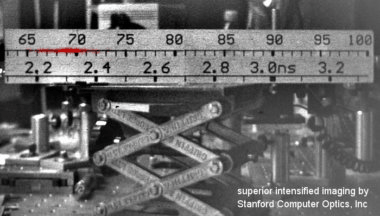Ultra High Speed Imaging
Ultra high speed CCD cameras capture the motion of light.

High speed ICCD cameras from Stanford Computer Optics provide state of the art ultrafast imaging. The ICCD cameras are widely used in the scientific field of ultra high speed imaging. The 4 Picos ICCD camera takes pictures with a shutter time of down to 200 picoseconds and a adjustable delay with 10ps step size. This ultra high speed camera has applications in many fields of physics, life science and metrology.
History of high speed imaging
In 1851, William Henry Fox attached a page of the London Times newspaper to a rotating wheel. He placed his wet-plate camera in front of the rotating newspaper and illuminated a few square inches of it for about 1/2000th of a second, using spark illumination from Leyden Jars. This first high speed photograph showed a readable part of the London Times and demonstrated therefore the possibility to capture motions which are happening way to fast for the human eye (1).
This was the beginning of the high speed imaging, also refereed to high speed photography. It has the goal to freeze motion on a picture with as little time passed as possible. Since 1851, many developments enhanced the performance of high speed imaging systems. Starting with exposure time ot 1/2000th of a second in 1851 the 4 Picos intensified camera has a minimal gating time of 200 picoseconds. This shutter speed enables temporal scanning of corresponding 5 billion frames per second. The framing camera XXRapidFrame even allow image sequences of up to 8 frames with a minimum interframing time of 10ps. Such a successive image sequences are taken with a corresponding frame rate of 100 billion frames per second.
ICCD camera captures the motion of light
The high speed shutter system of the 4 Picos with a gating time of 200 picoseconds enables trapping of the motion of light. This can be seen in the figure above where a 250 femtosecond laser pulse propagates perpendicular to the field of view of the ICCD camera. The gating time is adjust to 270 picoseconds with a increasing delay time to the Laser pulse. The individual images show the propagation of the Laser light along the calibration ruler. The changing brightness of the Laser pulses is due to the intensity fluctuations of the Laser source.

Setup of Laser pules measurement
In cooperation with the University College of London the scope of the 4 Picos ICCD camera can be obtained. The setup includes an 250 fs Laser which pulses are fan-shaped by a cylindrical lens and then guided to propagate along a calibration ruler. The 4 Picos ICCD camera is placed perpendicular to ruler and therefore perpendicular to the motion of the Laser pulses. The width of a 250fs Laser pulse is a fraction of a millimeter which is moving with speed of light along the calibration ruler. Therefore, the measured length of the Laser pulse is the distance the light has passed during the gating time of the ICCD camera. Hence the length of the Laser pulse is a direct measure of the gating time of the ICCD camera. This technique permit a direct measurement of the shutter time of any ultra high speed camera.
The upper scale of the calibration ruler shows the distance in centimeter. By considering the speed of light this distance is converted into a time scale which is displayed on the lower part of the ruler. Hence, the Laser pulse takes 1 nanosecond to move from the 2.2 ns marker on the left end of the image to the 3.2 ns marker on the right end. The background scene was imaged separately using the same ICCD camera just applying a long exposure time. After wards the individual Laser pulses where added to the background image in red color.
These measurements show the unique characteristics of the 4Picos high speed camera and its ability of sub-nanosecond imaging. The horizontal profile of a single shot femtosecond laser pulse is shown in the left. It shows the directly measured minimal gating time of the of the 4 Picos ICCD camera.
Application of ultra high speed imaging
The 4 Picos ICCD camera is user-optimized and does only need a 12V electric wire connection. It provides researchers with persuasive tool to take sharp images of objects moving with extremely high velocities. Within this classical application for ultra high speed imaging the 4 Picos intensified camera is used for PIV, shock waves analysis, ballistics and explosion measurements. Furthermore, ultra high speed imaging cameras with exposure times in the picoseconds regime allow the development of even more sophisticated applications such as 3D gated viewing laser radar, 2D imaging fluorescence or Sub-ns Thomson scattering analysis.
(1) A Brief History of High Speed Photography by Lincoln L. Endelman
